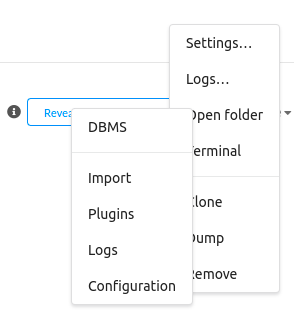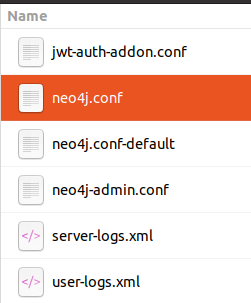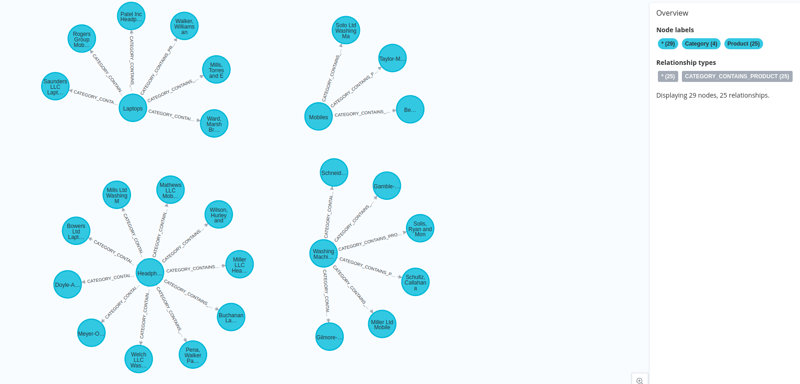将数据加载到 Neo4j 中
来源:dev.to
时间:2024-11-27 10:10:39 327浏览 收藏
大家好,我们又见面了啊~本文《将数据加载到 Neo4j 中》的内容中将会涉及到等等。如果你正在学习文章相关知识,欢迎关注我,以后会给大家带来更多文章相关文章,希望我们能一起进步!下面就开始本文的正式内容~
在上一篇博客中,我们了解了如何使用 2 个插件 apoc 和图形数据科学库 - gds 在本地安装和设置 neo4j。在这篇博客中,我将获取一个玩具数据集(电子商务网站中的产品)并将其存储在 neo4j 中。
为 neo4j 分配足够的内存
在开始加载数据之前,如果您的用例中有大量数据,请确保为 neo4j 分配了足够的内存。为此:
- 点击打开右侧的三个点

- 点击
- 打开文件夹-> 配置

- 点击
- neo4j.conf

- 在neo4j.conf中搜索
- heap,取消第77、78行的注释,并将256m更改为2048m,这样可以确保为neo4j中的数据存储分配2048mb。

- 图有两个主要组成部分:节点和关系,让我们先创建节点,然后再建立关系。
- 我正在使用的数据在这里 - data
- 使用这里提供的requirements.txt来创建一个python虚拟环境-requirements.txt
- 让我们定义各种函数来推送数据。
- 导入必要的库
import pandas as pd from neo4j import graphdatabase from openai import openai
- 我们将使用 openai 来生成嵌入
client = openai(api_key="")
product_data_df = pd.read_csv('../data/product_data.csv')
- 生成嵌入
def get_embedding(text):
"""
used to generate embeddings using openai embeddings model
:param text: str - text that needs to be converted to embeddings
:return: embedding
"""
model = "text-embedding-3-small"
text = text.replace("\n", " ")
return client.embeddings.create(input=[text], model=model).data[0].embedding
- 根据我们的数据集,我们可以有两个唯一的节点标签,
- category:产品类别,product:产品名称。让我们创建类别标签,neo4j 提供了一种称为属性的东西,您可以将它们想象为特定节点的元数据。这里 name 和 embedding 是属性。因此,我们将类别名称及其相应的嵌入存储在数据库中。
def create_category(product_data_df):
"""
used to generate queries for creating category nodes in neo4j
:param product_data_df: pandas dataframe - data
:return: query_list: list - list containing all create node queries for category
"""
cat_query = """create (a:category {name: '%s', embedding: %s})"""
distinct_category = product_data_df['category'].unique()
query_list = []
for category in distinct_category:
embedding = get_embedding(category)
query_list.append(cat_query % (category, embedding))
return query_list
- 类似地,我们可以创建产品节点,这里的属性是
- name,description,price,warranty_period,available_stock,review_ rating,product_release_date,embedding
def create_product(product_data_df):
"""
used to generate queries for creating product nodes in neo4j
:param product_data_df: pandas dataframe - data
:return: query_list: list - list containing all create node queries for product
"""
product_query = """create (a:product {name: '%s', description: '%s', price: %d, warranty_period: %d,
available_stock: %d, review_rating: %f, product_release_date: date('%s'), embedding: %s})"""
query_list = []
for idx, row in product_data_df.iterrows():
embedding = get_embedding(row['product name'] + " - " + row['description'])
query_list.append(product_query % (row['product name'], row['description'], int(row['price (inr)']),
int(row['warranty period (years)']), int(row['stock']),
float(row['review rating']), str(row['product release date']), embedding))
return query_list
- 现在让我们创建另一个函数来执行上述两个函数生成的查询。适当更新您的用户名和密码。
def execute_bulk_query(query_list):
"""
executes queries is a list one by one
:param query_list: list - list of cypher queries
:return: none
"""
url = "bolt://localhost:7687"
auth = ("neo4j", "neo4j@123")
with graphdatabase.driver(url, auth=auth) as driver:
with driver.session() as session:
for query in query_list:
try:
session.run(query)
except exception as error:
print(f"error in executing query - {query}, error - {error}")
- 完整代码
import pandas as pd
from neo4j import graphdatabase
from openai import openai
client = openai(api_key="")
product_data_df = pd.read_csv('../data/product_data.csv')
def preprocessing(df, columns_to_replace):
"""
used to preprocess certain column in dataframe
:param df: pandas dataframe - data
:param columns_to_replace: list - column name list
:return: df: pandas dataframe - processed data
"""
df[columns_to_replace] = df[columns_to_replace].apply(lambda col: col.str.replace("'s", "s"))
df[columns_to_replace] = df[columns_to_replace].apply(lambda col: col.str.replace("'", ""))
return df
def get_embedding(text):
"""
used to generate embeddings using openai embeddings model
:param text: str - text that needs to be converted to embeddings
:return: embedding
"""
model = "text-embedding-3-small"
text = text.replace("\n", " ")
return client.embeddings.create(input=[text], model=model).data[0].embedding
def create_category(product_data_df):
"""
used to generate queries for creating category nodes in neo4j
:param product_data_df: pandas dataframe - data
:return: query_list: list - list containing all create node queries for category
"""
cat_query = """create (a:category {name: '%s', embedding: %s})"""
distinct_category = product_data_df['category'].unique()
query_list = []
for category in distinct_category:
embedding = get_embedding(category)
query_list.append(cat_query % (category, embedding))
return query_list
def create_product(product_data_df):
"""
used to generate queries for creating product nodes in neo4j
:param product_data_df: pandas dataframe - data
:return: query_list: list - list containing all create node queries for product
"""
product_query = """create (a:product {name: '%s', description: '%s', price: %d, warranty_period: %d,
available_stock: %d, review_rating: %f, product_release_date: date('%s'), embedding: %s})"""
query_list = []
for idx, row in product_data_df.iterrows():
embedding = get_embedding(row['product name'] + " - " + row['description'])
query_list.append(product_query % (row['product name'], row['description'], int(row['price (inr)']),
int(row['warranty period (years)']), int(row['stock']),
float(row['review rating']), str(row['product release date']), embedding))
return query_list
def execute_bulk_query(query_list):
"""
executes queries is a list one by one
:param query_list: list - list of cypher queries
:return: none
"""
url = "bolt://localhost:7687"
auth = ("neo4j", "neo4j@123")
with graphdatabase.driver(url, auth=auth) as driver:
with driver.session() as session:
for query in query_list:
try:
session.run(query)
except exception as error:
print(f"error in executing query - {query}, error - {error}")
# preprocessing
product_data_df = preprocessing(product_data_df, ['product name', 'description'])
# create category
query_list = create_category(product_data_df)
execute_bulk_query(query_list)
# create product
query_list = create_product(product_data_df)
execute_bulk_query(query_list)
- 我们将在
- category 和 product 之间创建关系,该关系的名称为 category_contains_product
from neo4j import GraphDatabase
import pandas as pd
product_data_df = pd.read_csv('../data/product_data.csv')
def preprocessing(df, columns_to_replace):
"""
Used to preprocess certain column in dataframe
:param df: pandas dataframe - data
:param columns_to_replace: list - column name list
:return: df: pandas dataframe - processed data
"""
df[columns_to_replace] = df[columns_to_replace].apply(lambda col: col.str.replace("'s", "s"))
df[columns_to_replace] = df[columns_to_replace].apply(lambda col: col.str.replace("'", ""))
return df
def create_category_food_relationship_query(product_data_df):
"""
Used to create relationship between category and products
:param product_data_df: dataframe - data
:return: query_list: list - cypher queries
"""
query = """MATCH (c:Category {name: '%s'}), (p:Product {name: '%s'}) CREATE (c)-[:CATEGORY_CONTAINS_PRODUCT]->(p)"""
query_list = []
for idx, row in product_data_df.iterrows():
query_list.append(query % (row['Category'], row['Product Name']))
return query_list
def execute_bulk_query(query_list):
"""
Executes queries is a list one by one
:param query_list: list - list of cypher queries
:return: None
"""
url = "bolt://localhost:7687"
auth = ("neo4j", "neo4j@123")
with GraphDatabase.driver(url, auth=auth) as driver:
with driver.session() as session:
for query in query_list:
try:
session.run(query)
except Exception as error:
print(f"Error in executing query - {query}, Error - {error}")
# PREPROCESSING
product_data_df = preprocessing(product_data_df, ['Product Name', 'Description'])
# CATEGORY - FOOD RELATIONSHIP
query_list = create_category_food_relationship_query(product_data_df)
execute_bulk_query(query_list)
- 通过使用 match 查询来匹配已经创建的节点,我们在它们之间建立关系。
将鼠标悬停在
open图标上,然后单击neo4j浏览器以可视化我们创建的节点。



在接下来的博客中,我们将看到如何使用 python 构建图形查询引擎并使用获取的数据进行增强生成。
linkedin - https://www.linkedin.com/in/praveenr2998/
github - https://github.com/praveenr2998/creating-lightweight-rag-systems-with-graphs/tree/main/push_data_to_db
今天带大家了解了的相关知识,希望对你有所帮助;关于文章的技术知识我们会一点点深入介绍,欢迎大家关注golang学习网公众号,一起学习编程~
声明:本文转载于:dev.to 如有侵犯,请联系study_golang@163.com删除
相关阅读
更多>
-
501 收藏
-
501 收藏
-
501 收藏
-
501 收藏
-
501 收藏
最新阅读
更多>
-
422 收藏
-
345 收藏
-
253 收藏
-
263 收藏
-
362 收藏
-
297 收藏
-
195 收藏
-
339 收藏
-
245 收藏
-
211 收藏
-
204 收藏
-
147 收藏
课程推荐
更多>
-

- 前端进阶之JavaScript设计模式
- 设计模式是开发人员在软件开发过程中面临一般问题时的解决方案,代表了最佳的实践。本课程的主打内容包括JS常见设计模式以及具体应用场景,打造一站式知识长龙服务,适合有JS基础的同学学习。
- 立即学习 543次学习
-

- GO语言核心编程课程
- 本课程采用真实案例,全面具体可落地,从理论到实践,一步一步将GO核心编程技术、编程思想、底层实现融会贯通,使学习者贴近时代脉搏,做IT互联网时代的弄潮儿。
- 立即学习 516次学习
-

- 简单聊聊mysql8与网络通信
- 如有问题加微信:Le-studyg;在课程中,我们将首先介绍MySQL8的新特性,包括性能优化、安全增强、新数据类型等,帮助学生快速熟悉MySQL8的最新功能。接着,我们将深入解析MySQL的网络通信机制,包括协议、连接管理、数据传输等,让
- 立即学习 500次学习
-

- JavaScript正则表达式基础与实战
- 在任何一门编程语言中,正则表达式,都是一项重要的知识,它提供了高效的字符串匹配与捕获机制,可以极大的简化程序设计。
- 立即学习 487次学习
-

- 从零制作响应式网站—Grid布局
- 本系列教程将展示从零制作一个假想的网络科技公司官网,分为导航,轮播,关于我们,成功案例,服务流程,团队介绍,数据部分,公司动态,底部信息等内容区块。网站整体采用CSSGrid布局,支持响应式,有流畅过渡和展现动画。
- 立即学习 485次学习
